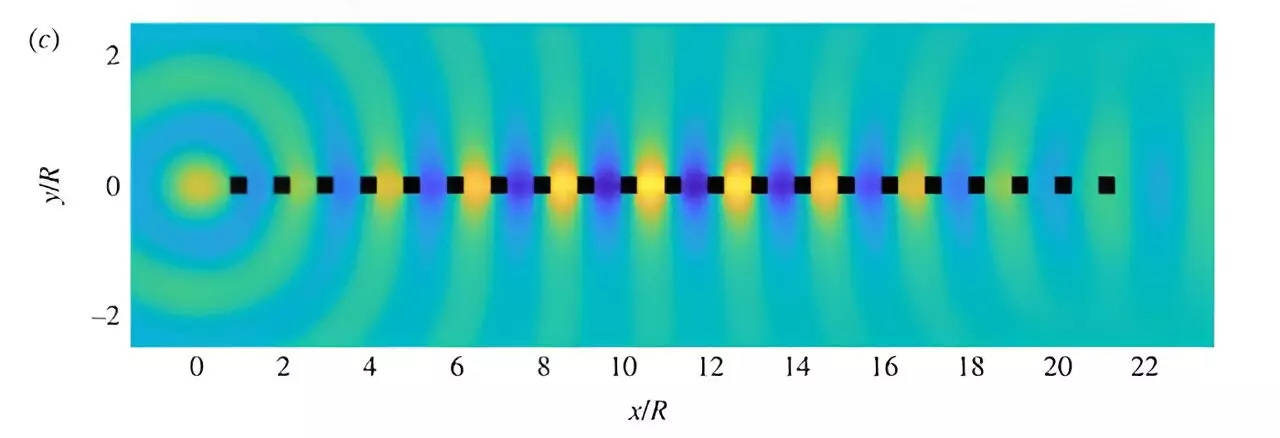The evolution of materials science has embarked on a transformative journey, propelled by advancements in computational tools. A recent innovation from Macquarie University, the TMATSOLVER software, opens new avenues in how we understand and manipulate wave interactions with various particles. This pioneering tool empowers researchers to explore metamaterials—unconventional materials designed to influence waves in unprecedented ways—with remarkable efficiency and accuracy.
Metamaterials possess unique properties that are absent in natural substances, enabling the control and manipulation of electromagnetic, acoustic, and other types of waves. Traditional approaches to modeling wave scattering often fell short, particularly when addressing complex particle geometries or larger size scales. As the demand for tailored metamaterial applications surged, from invisibility cloaks to enhanced imaging systems, there arose a critical need for more sophisticated modeling techniques. The introduction of TMATSOLVER marks a significant advancement, addressing the computational bottlenecks that hampered rigorous metamaterial experimentation.
Developed by a collaborative team spearheaded by Dr. Stuart Hawkins, TMATSOLVER employs a multipole-based methodology to simulate and visualize how various waves scatter when encountering diverse particle shapes and properties. Notably, this innovative software can accommodate configurations of hundreds of scatterers simultaneously, effectively managing the complexities that arise as particle shapes become irregular or intricate.
According to Dr. Hawkins, the software’s foundation lies in the transition matrix (T-matrix)—a mathematical representation involving a series of numerical grids that succinctly encapsulate how particular objects scatter waves. While the concept of the T-matrix has been utilized since the 1960s, the advancements made by Hawkins and his team significantly enhance its applicability to larger dimensions and complex particle structures. The capability to model previously unapproachable configurations illustrates not only the software’s technical superiority but also its relevance in the evolving landscape of metamaterial research.
The development of TMATSOLVER is not a solitary journey; it is the result of collaborative efforts among esteemed mathematicians and researchers from prestigious institutions, including the University of Adelaide and several prominent UK and German universities. This transnational collaboration highlights the global imperative of tackling scientific challenges through shared knowledge and interdisciplinary teams.
Dr. Luke Bennetts, a co-author of the study, emphasizes that TMATSOLVER alleviates computational bottlenecks, allowing researchers to generalize their findings across more complex geometries. Such advancements are crucial for rapidly experimenting and validating theoretical approaches in metamaterial design, thereby shortening the research cycle from conception to practical application.
In their pivotal study published in the *Proceedings of the Royal Society A*, the researchers showcased TMATSOLVER’s capabilities through multiple case studies involving metamaterial design challenges. These examples ranged from exploring anisotropic particle arrays to crafting high-contrast square particles and tunable periodic structures capable of wave manipulation. By demonstrating the software’s versatility and power, the study not only contributes to the academic community but also sets a precedent for industrial applications.
The implications of this research extend far beyond theoretical exploration. As society grapples with pressing issues such as energy efficiency and noise reduction, the insights garnered from TMATSOLVER could spearhead innovations in diverse sectors. For instance, super-lenses allow observation at molecular depths, while adept wave absorption techniques promise advancements in clean energy harvesting.
The significance of TMATSOLVER resonates within the scientific community, promising to quicken the pace of metamaterial research and development in a burgeoning global market. Professor Lucy Marshall from Macquarie University aptly underscores the importance of this research: “This is a prime example of how innovative computational methods can drive advancements in materials science and engineering.” As the demand for high-performance metamaterials grows, TMATSOLVER stands poised to play a critical role in the drive for practical and cutting-edge solutions.
The quest for innovative metamaterials, guided by the revolutionary capabilities of TMATSOLVER, heralds a new era in materials science. Through meticulous research and collaborative efforts, the potential to reshape our interaction with waves could redefine scientific boundaries and foster solutions to some of the world’s most pressing challenges. Thus, the power of computational advancements continues to unveil the mysteries of wave-matter interactions, leading to infinite possibilities for technology and beyond.


Leave a Reply